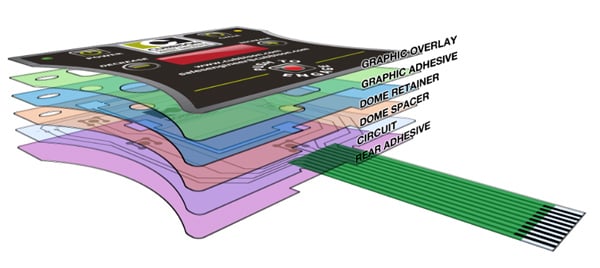How a Membrane Switch Improves Individual Experience and Tool Efficiency
How a Membrane Switch Improves Individual Experience and Tool Efficiency
Blog Article
Just How Membrane Layer Changes Contribute to the Longevity of Electronic Control Panels
Membrane layer switches play an important role in boosting the toughness of electronic control panels, mainly via their multi-layered building and construction which supplies efficient defense versus ecological variables such as dampness and dust. The lack of moving parts considerably reduces the chance of mechanical failures, making membrane switches over perfect for requiring applications.
Meaning of Membrane Switches

Membrane layer switches are made to be slim and lightweight, making them ideal for applications where room is limited. They can be manufactured in numerous forms, sizes, and shades, offering versatility in style that fulfills visual and useful demands. Furthermore, membrane layer buttons can include numerous technologies, such as tactile comments and LED indicators, boosting customer experience.
Because of their building and construction, membrane layer switches are often immune to dirt, wetness, and general wear, adding to their resilience popular environments. Their smooth design not only facilitates easy cleaning yet also reduces the threat of mechanical failure, making them a preferred option for makers seeking trustworthy interface in their electronic control panels.
Protection Against Ecological Factors
The layout of membrane layer switches inherently supplies a degree of protection against different ecological variables, which is crucial for keeping capability in difficult conditions - Membrane Switch. These buttons are typically created with layers of versatile products that protect internal parts from wetness, dirt, and pollutants. By encapsulating the wiring, membrane layer changes minimize the threat of short circuits and deterioration, which can significantly hinder performance
In addition, the usage of durable adhesives and sealers throughout production enhances their resistance to ecological challenges. Membrane buttons can withstand direct exposure to chemicals and solvents, making them suitable for markets such as food handling and medical care, where health and sanitation are extremely important. Their smooth surface layout additionally prevents the build-up of dirt and germs, assisting in simpler cleaning and maintenance.
Temperature variations are another ecological worry, and membrane buttons are engineered to function properly across a large range of temperatures (Membrane Switch). This adaptability ensures that control board stay operational in numerous setups, from industrial settings to consumer electronic devices
Effect On Customer Interaction
User interaction with electronic control panels is considerably affected by the layout and capability of membrane switches. These switches give a tactile user interface that boosts the general customer experience, enabling user-friendly navigating and control. Their receptive nature ensures that individuals get immediate comments upon activation, which is vital for tasks requiring precision and performance.
In addition, the smooth surface of membrane layer switches over facilitates very easy cleaning and maintenance, review promoting customer confidence in the integrity of the user interface. This sanitation is particularly vital in settings where hygiene is vital, such as medical or food handling settings. Additionally, the compact and light-weight layout of membrane layer switches adds to the aesthetic allure of control board, urging user interaction via a contemporary and sleek appearance.
In addition, the combination of aesthetic aspects, such as printed symbols and backlighting, aids individuals rapidly recognize features, reducing the finding out curve connected with new tools. Because of this, customers can run gadgets better, causing raised productivity and satisfaction. In recap, membrane buttons play a critical role in enhancing user communication by integrating performance, aesthetic appeals, and ease of use, eventually leading to boosted operational efficiency.
Design Versatility and Customization
Design versatility and personalization are vital elements of membrane layer switches, enabling suppliers to tailor digital control panels to certain applications and user requirements. This flexibility enables the integration of various design components, such as shades, graphics, and structures, which can improve the aesthetic appeal and individual engagement of the control board.
Membrane layer switches can be tailored in dimension and shape, suiting a variety of devices and applications, from commercial machinery to consumer electronics. This adaptability guarantees that my link suppliers can produce intuitive interfaces that line up with customer assumptions and operational needs. Furthermore, the capability to integrate special functions such as backlighting or responsive feedback additionally enhances usability, allowing for an extra interactive experience.
Moreover, the manufacturing process for membrane switches sustains the rapid prototyping of styles, making it possible for manufacturers to repeat and improve their principles promptly. This capacity not only speeds up the advancement timeline however likewise makes sure that the end product meets specific useful and visual criteria.

Cost-Effectiveness and Durability
Cost-effectiveness and durability are significant advantages of membrane layer buttons, making them an appealing option for makers and end-users alike. These switches are generally cheaper to produce than standard mechanical buttons, largely due to their streamlined manufacturing procedures and the decreased variety of elements required. This expense advantage expands not only website link to initial manufacturing yet likewise to lasting functional expenses, as membrane layer switches frequently require less upkeep and have a reduced failing rate.
In addition, the durability of membrane layer changes adds to their overall worth. Built from durable products, they are immune to environmental factors such as dampness, dust, and chemicals, which can cause premature wear in various other switch types. The lack of relocating parts decreases mechanical failing, permitting membrane layer switches to preserve capability over extended durations.
This sturdiness is particularly valuable in applications needing regular performance under demanding problems, such as medical tools and industrial devices. Eventually, the combination of cost-effectiveness and durability makes membrane layer switches an economically practical selection for makers, supplying dependable remedies that endure the examination of time while maximizing budgetary considerations.
Final Thought
In final thought, membrane layer switches considerably enhance the sturdiness of electronic control panels through their durable building and construction and safety functions - Membrane Switch. Generally, membrane switches stand for a trusted and affordable selection for enhancing the durability and functionality of digital control systems.
Report this page